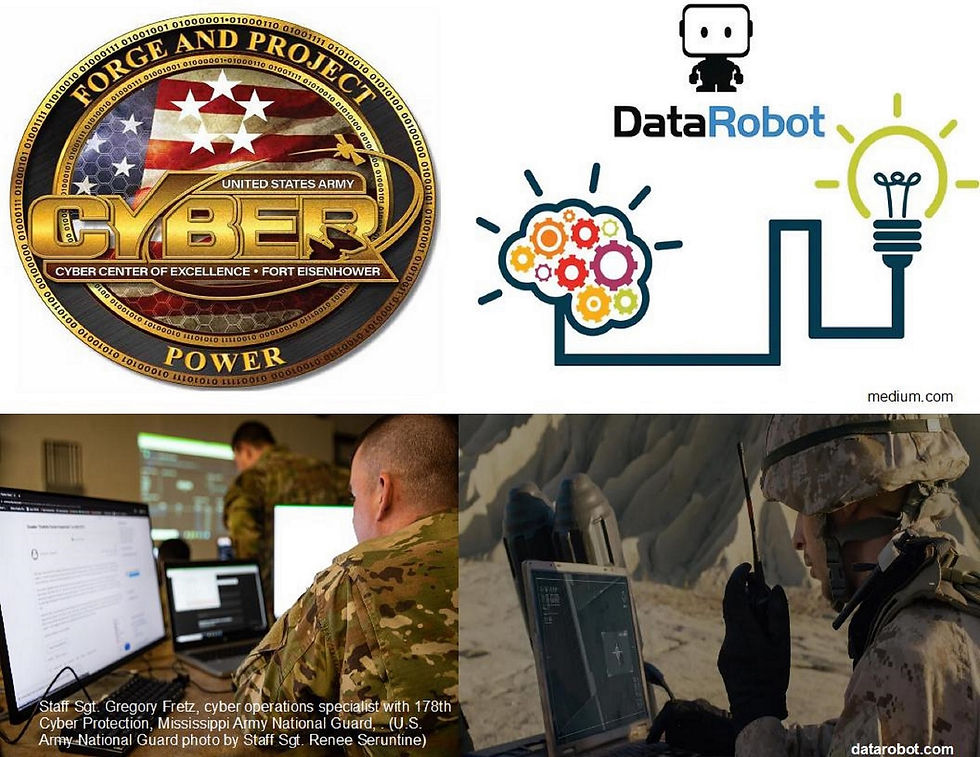US Military Targets Deepfakes And Misinformation With AI-Powered Tool
- Ken Larson

- Aug 7, 2023
- 3 min read

“C4ISRNET” By Colin Demarest and Jaime Moore-Carrillo
“The U.S. military is testing an artificial intelligence tool that can trawl social media and other open-source information and spot misleading content, such as bots or deepfakes, to better inform commanders of the region they are operating in.”
_______________________________________________________________________________
“The program, dubbed Data Robot, was part of the Cyber Quest trials held throughout July at Fort Gordon [recently renamed Ft. Eisenhower] in Georgia. It was previously put through its paces during the Pacific Sentry exercise in Hawaii, officials said.
“We want to give the commanders the right information at the right time so we can impact the enemy. That’s the goal,” Army Col. Brett Riddle, director of the Cyber Battle Lab, told reporters at a Cyber Quest briefing July 28. “And I think Data Robot did show us that we can start to progress forward with that.”
Quickly discerning fact from fiction is critical for forces in the field. And the task is increasingly complex as misinformation floods the likes of Twitter and Facebook and world powers wage online influence campaigns, some more overt than others. A manipulated video surfaced last year in which a poorly edited Ukrainian President Volodymyr Zelenskyy called on his soldiers to lay down their arms and surrender to Russia, for example. It was quickly debunked.
The U.S. is now beefing up its information warfare capabilities, a persuasive combination of data awareness and deception aimed at gaining an advantage before, during and after battles. Cyber Quest is organized each year to examine up-and-coming technologies and inform future investments.
“It’s our opportunity to take cutting-edge, newly delivered products from industry, put them into the hands of soldiers and determine if they’re going to work in the field, in the dirt, in the rain, in Georgia, in the hot, humid weather,” Army Maj. Gen. Paul Stanton, the commander of the Army cyber center of excellence, said. “We need opportunities like Cyber Quest to work directly alongside our industry and scientific partners so they can make the modifications to existing protocols so that they’ll meet our needs.”
The Data Robot tool required about 90 days’ worth of data to reference before effectively identifying messages pushed by bots, according to Stanton. Pattern recognition and other insights are derived from extensive training regimens.
“Was anyone using artificial intelligence and machine learning? The simple answer is yes,” Stanton said of Cyber Quest. “Social media in the Indo-Pacific doesn’t look like social media in the United States.”
Data Robot could eventually fold into the Command Post Computing Environment to provide snapshots of information, though it will require some troubleshooting, officials said.
The environment consolidates various programs and data streams into a common pane maintained by soldiers. It also provides a software and hardware framework upon which future applications can be built.
“There was a lot of promising work done here at Cyber Quest,” Riddle said. “When we look at information advantage and trying to produce those visual overlays for commanders, it can be done.”
About Colin Demarest and Jaime Moore-Carrillo
Colin Demarest is a reporter at C4ISRNET, where he covers military networks, cyber and IT. Colin previously covered the Department of Energy and its National Nuclear Security Administration — namely Cold War cleanup and nuclear weapons development — for a daily newspaper in South Carolina. Colin is also an award-winning photographer.
Jaime Moore-Carrillo is an editorial fellow for Military Times and Defense News. A Boston native, Jaime graduated with degrees in international affairs, history, and Arabic from Georgetown University, where he served as a senior editor for the school’s student-run paper, The Hoya.




Comments